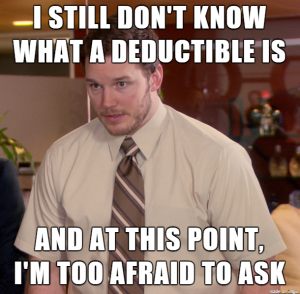When shopping for insurance, one of the biggest mistakes a person can make is not choosing the correct deductible. When making your deductible decisions be aware that every persons situation is different, which means you need to have a deductible that fits YOU!

So what is a deductible? The deductible is the amount paid out of pocket by the policy holder before an insurance provider will pay any expenses. So what does this mean? Well, basically it means that you are sharing a portion of the risk with the insurance company. This is why it is important to choose the correct deductible, as some people may be able to share in more of the risk, while others may not be able to afford it.
How does the deductible affect my insurance policy?
Your deductible primarily affects the price of the policy. A higher deductible will mean a lower premium, while a lower deductible will mean a higher premium. So it is important to review all your deductible options as each option will affect premium in some way.
Who do I pay my deductible to?
A common misconception in insurance is who I will pay my deductible to. All too often we will have an insured believe that they are supposed to pay their deductible to their insurance agent or insurance company, but in reality you pay your deductible to whomever is making your claim right. Meaning in an auto insurance claim, you might pay the body shop that is fixing your vehicle. Or in a homeowners claim, you might pay your contractor who is fixing your house.
So how do I choose the right deductible?
First, there are some questions that you will need to ask yourself before you can determine what deductible is right for you.
How healthy is your rainy day fund?
Do you have an emergency fund where you would be able to afford an unexpected expense like your deductible? If your fund is extremely healthy, you might want to look at choosing a higher deductible, such as $1,000. But if you are struggling and aren’t able to save much for these unexpected expenses, you might be better suited for a lower deductible. Finding a way to pay your deductible shouldn’t be so stressful that you loose sleep at night.
What is the value of the item being insured?
This question doesn’t apply in every scenario. For example, your home is obviously worth more than the typical $500 deductible that many homeowners pick for their home insurance policies. But what about your auto insurance policy’s collision and comprehensive deductibles? The value of your car primarily comes into play when there’s an older car involved which can make choosing deductibles a bit tricky. In fact, depending on the value of your vehicle you may want to reconsider having collision or comprehensive coverage at all.
Let’s say you’ve got an older vehicle that’s valued at $1,100. Having collision or comprehensive coverage with $500 deductibles means the maximum payout should you need to submit a claim will be $600. Is the coverage worth it given the extra premium you’ll pay? It’s a balancing act and a personal choice but it’s something that needs to be thought out.
How often will I make a claim?
Often people select lower deductibles, so their out-of-pocket expenses are minimal at the time of a claim. They plan for the worst case “what if” scenario. But, if you’ve been fortunate to have never submitted a claim or have rarely needed to, and you can afford the deductible you ultimately choose, a higher deductible may help lower your annual premiums.
Percentage Deductibles
About percentage deductibles. A 1% deductible is confusing for most people, as they believe that it is just 1% of the claim. But in reality a 1% deductible.
Example: Home insured for $250,000 with a 2% deductible. This means that you have a $5,000 deductible, not just 2% of the loss amount.
Try and stay away from percentage deductibles.
So what is my best option?
Since every situation is different, it is best to evaluate each situation with your insurance agent. That is where we come in to help! YAY! So if you have any questions with your deductibles, please speak to us!
